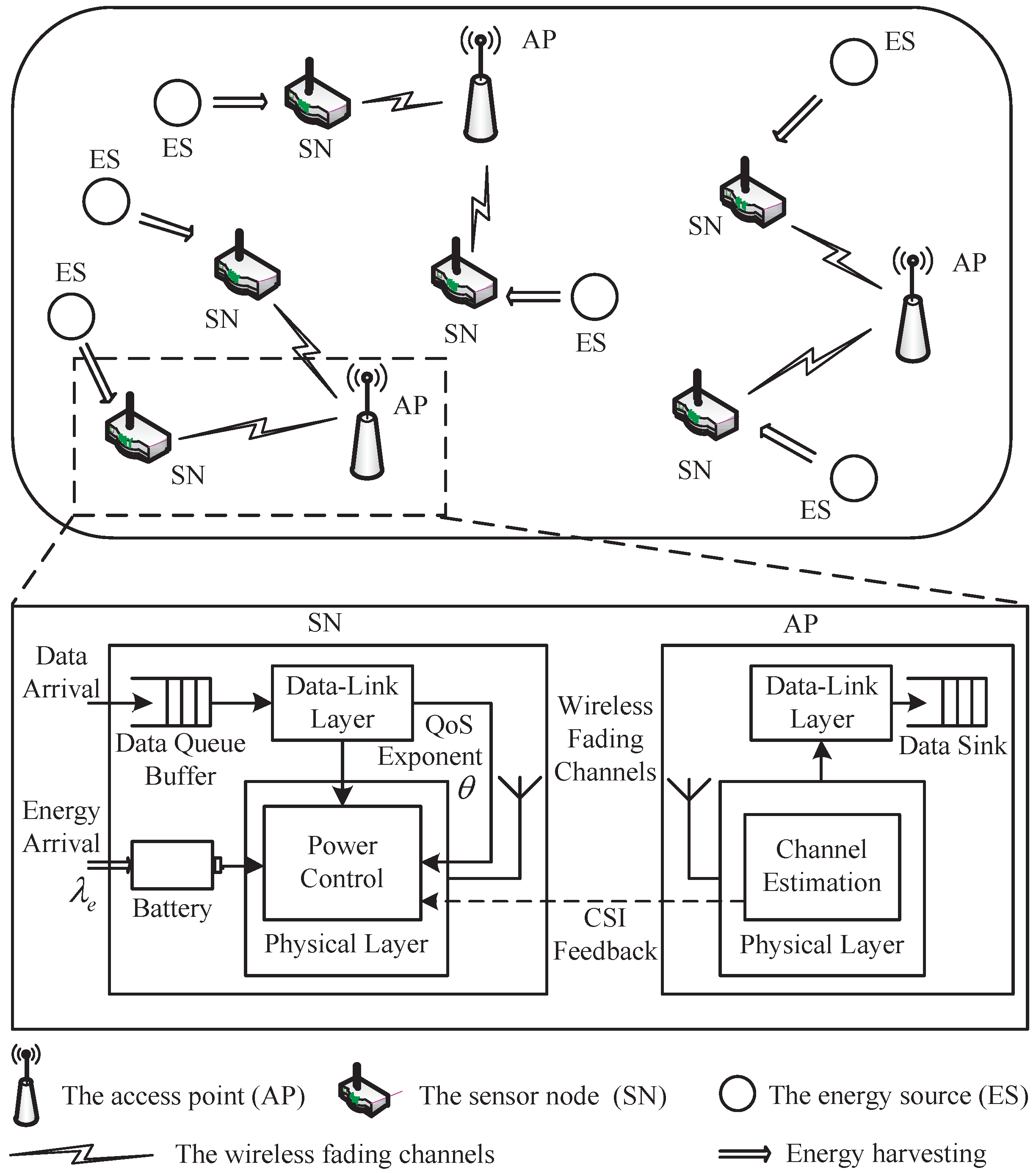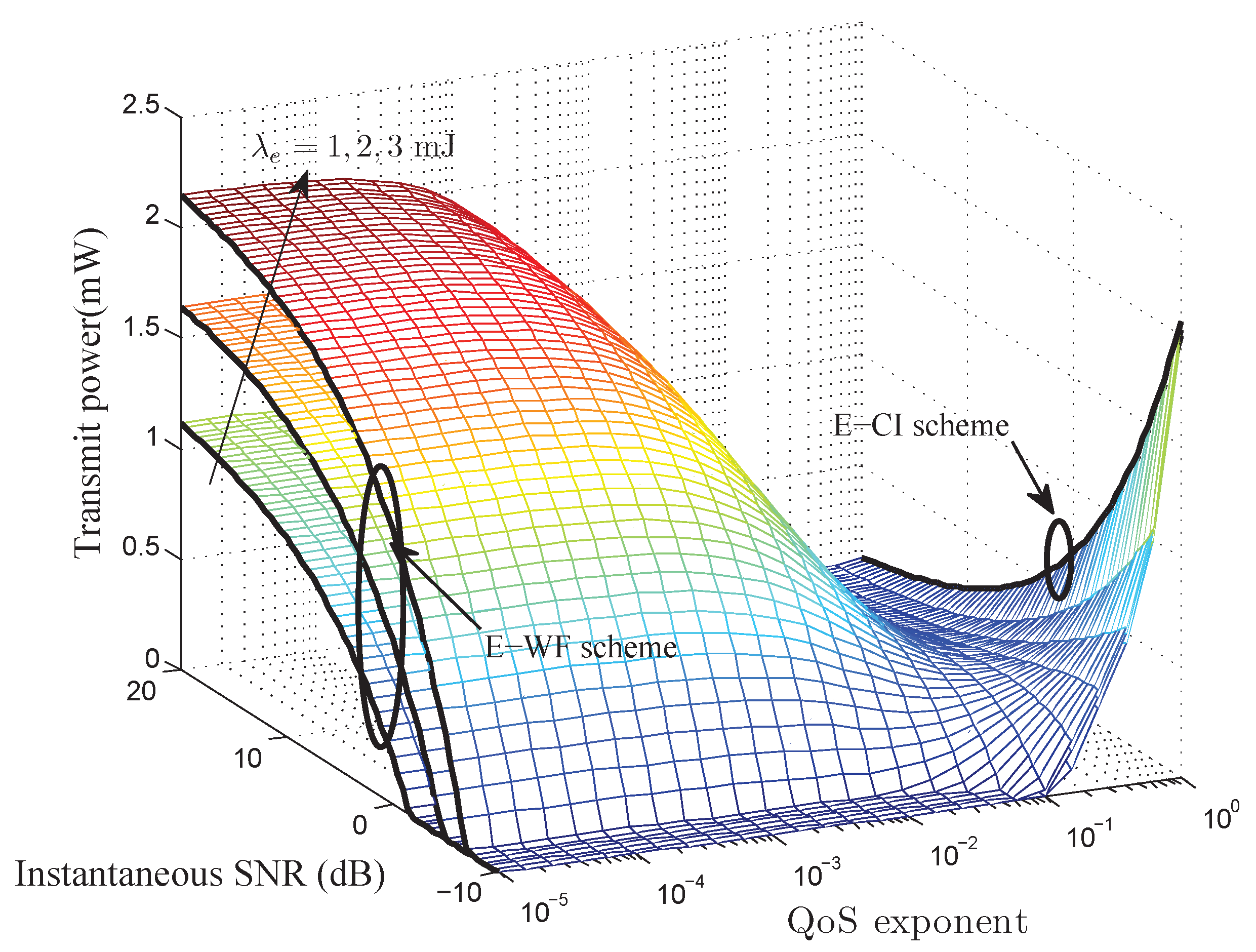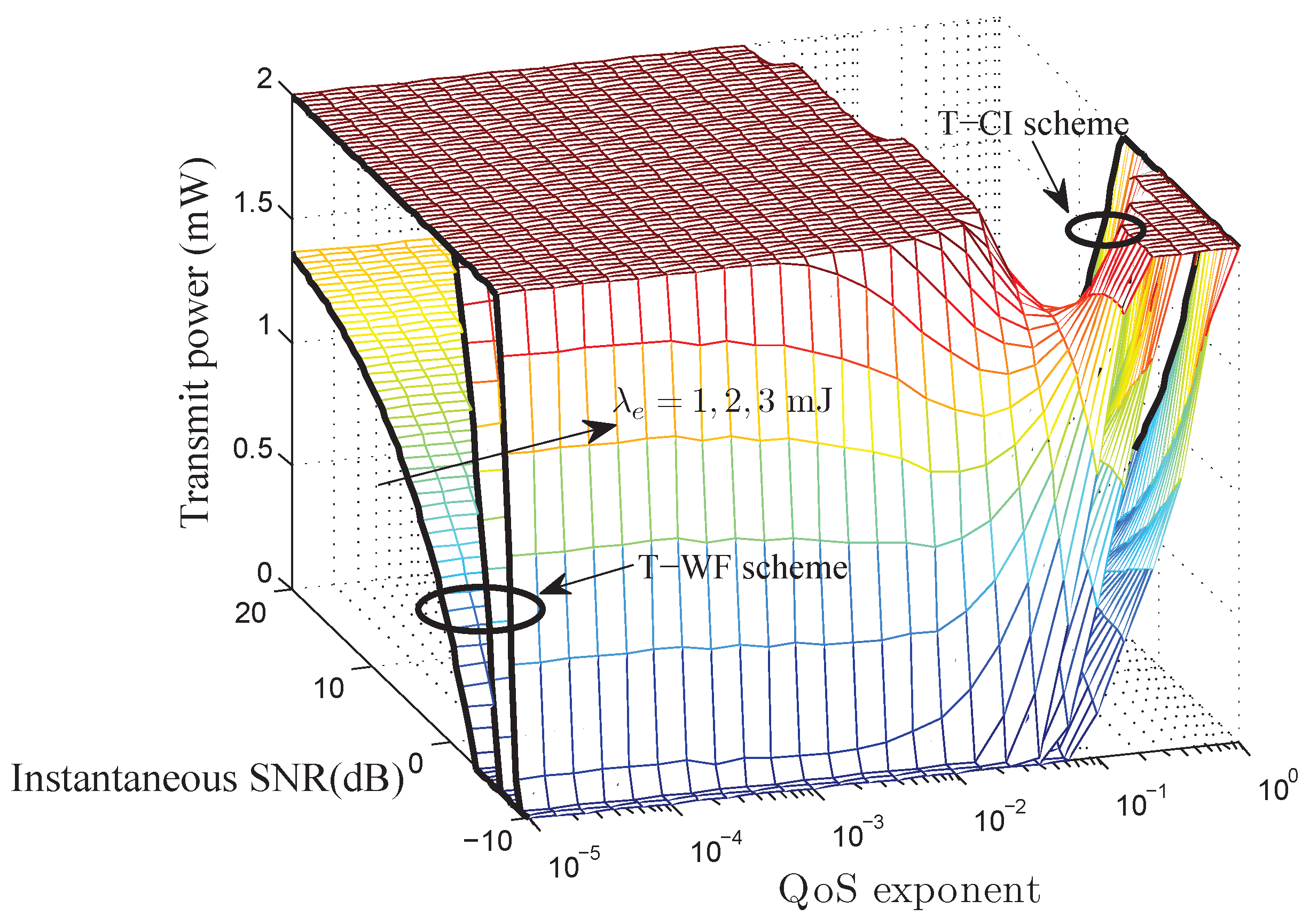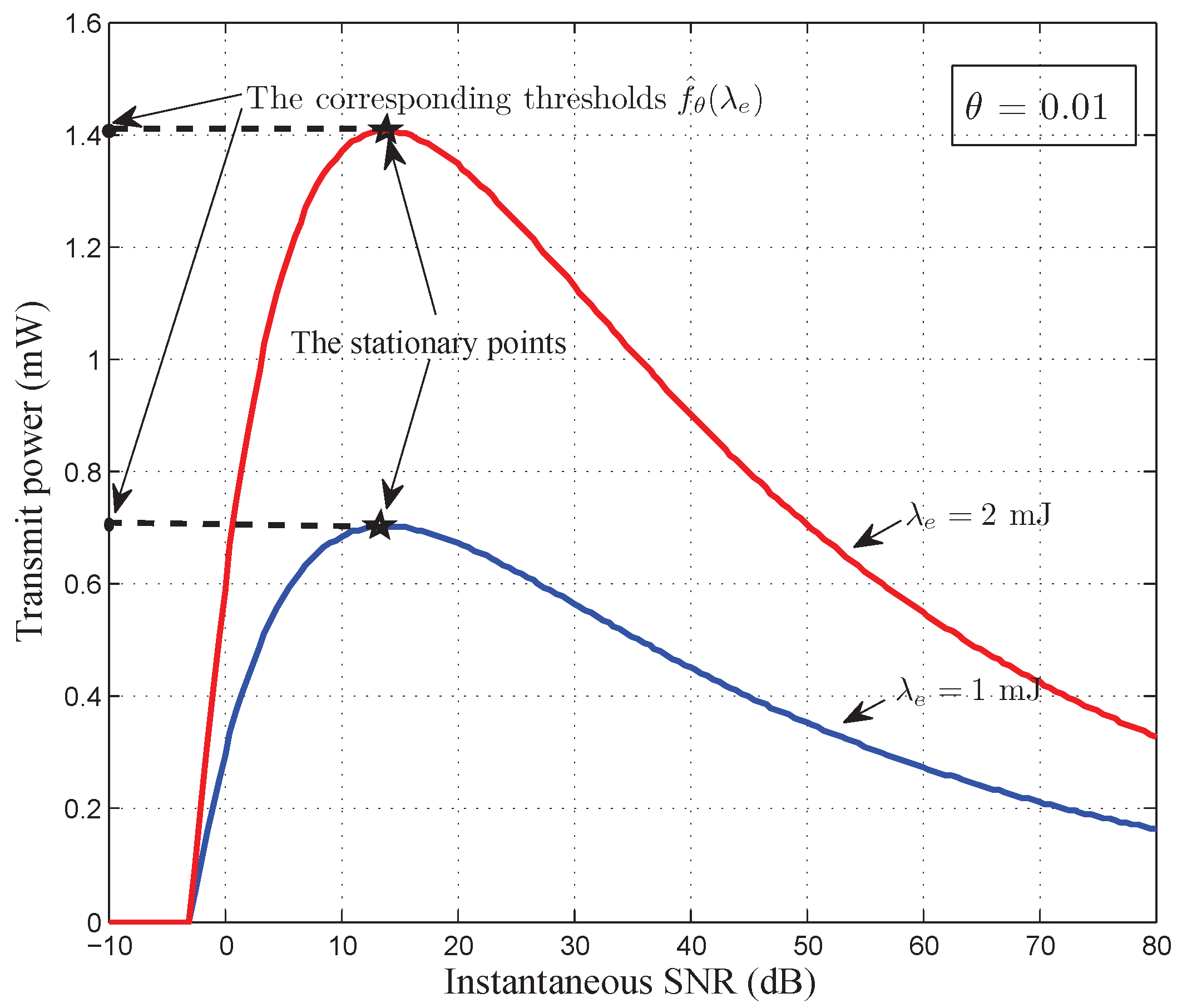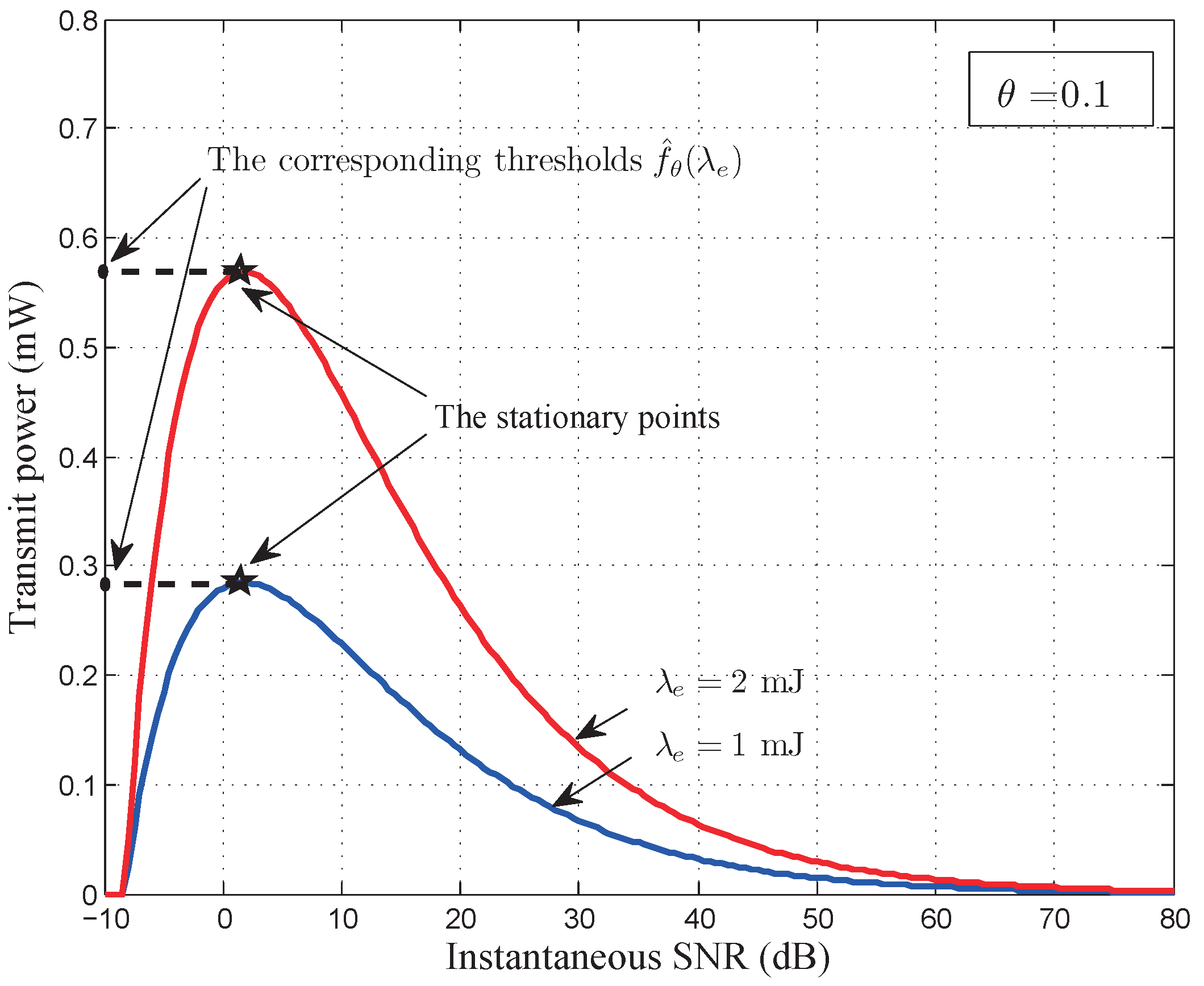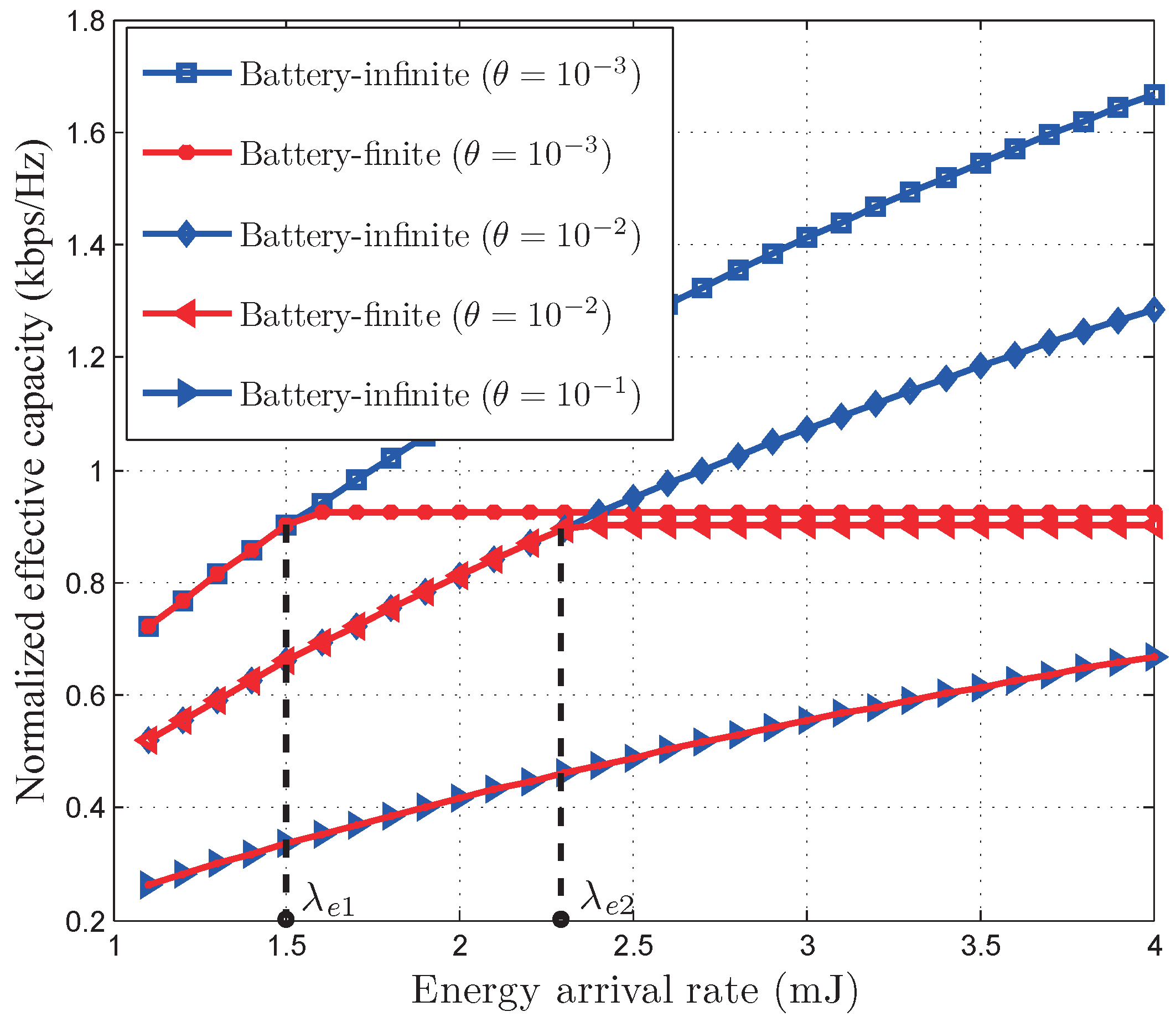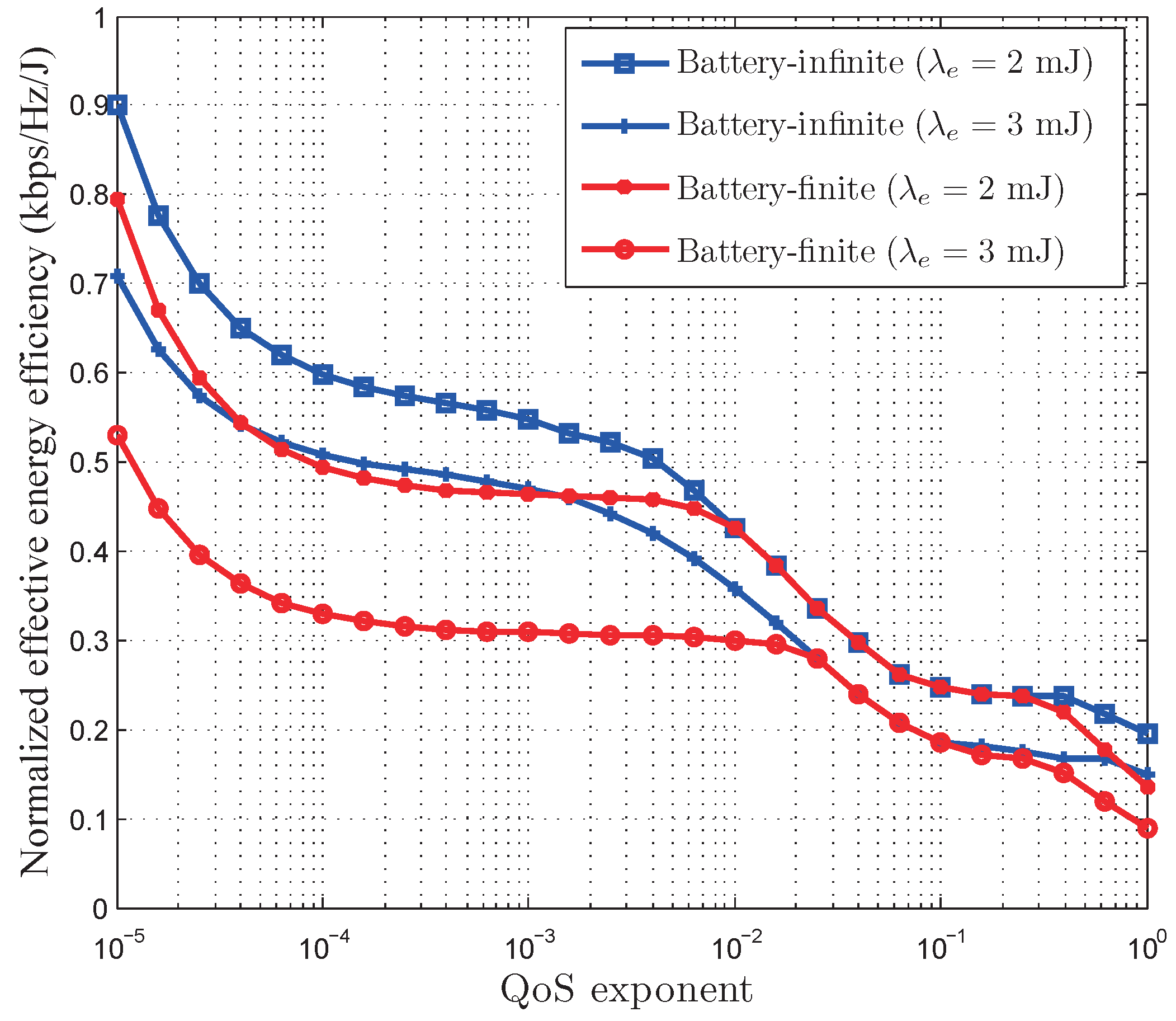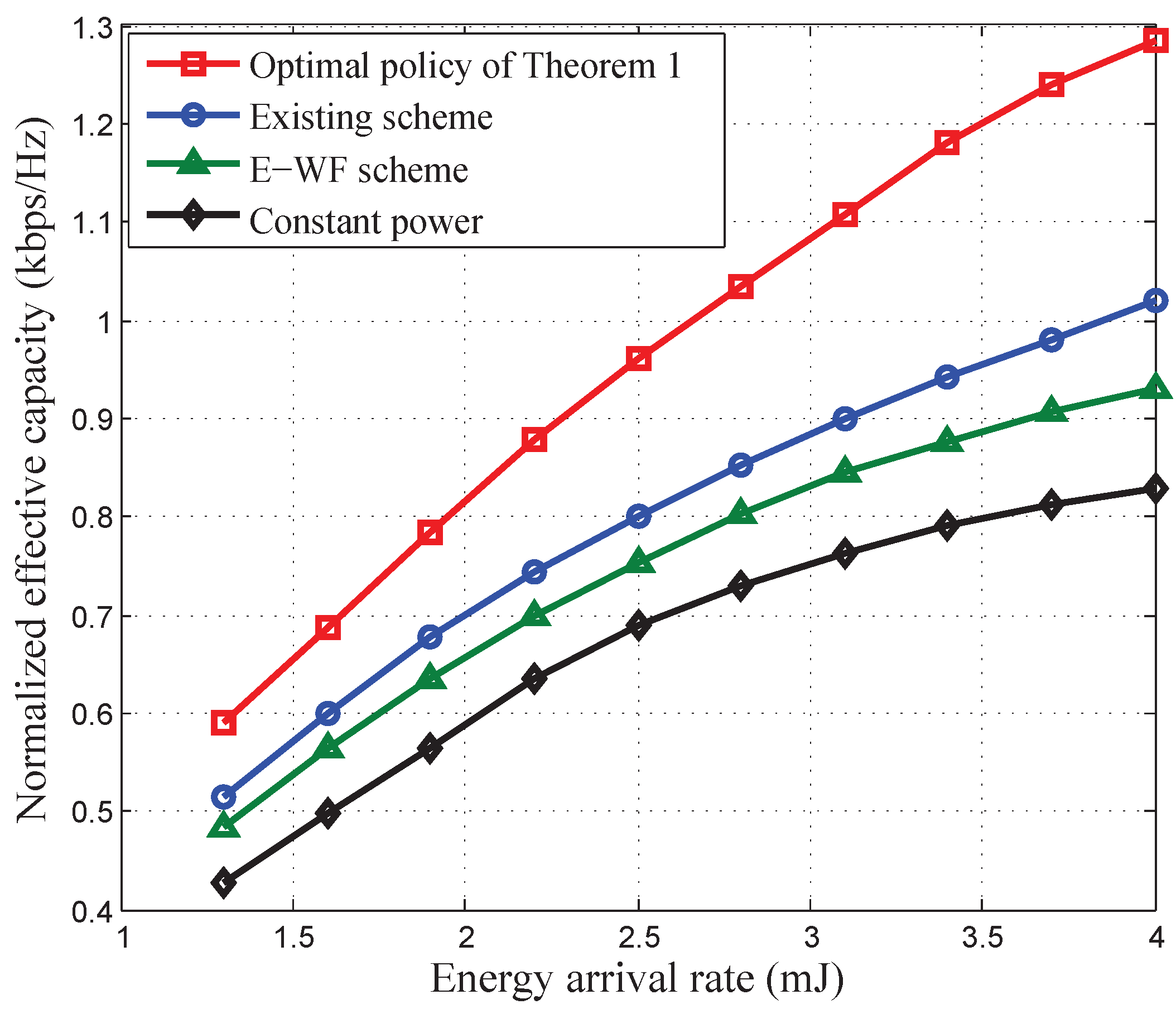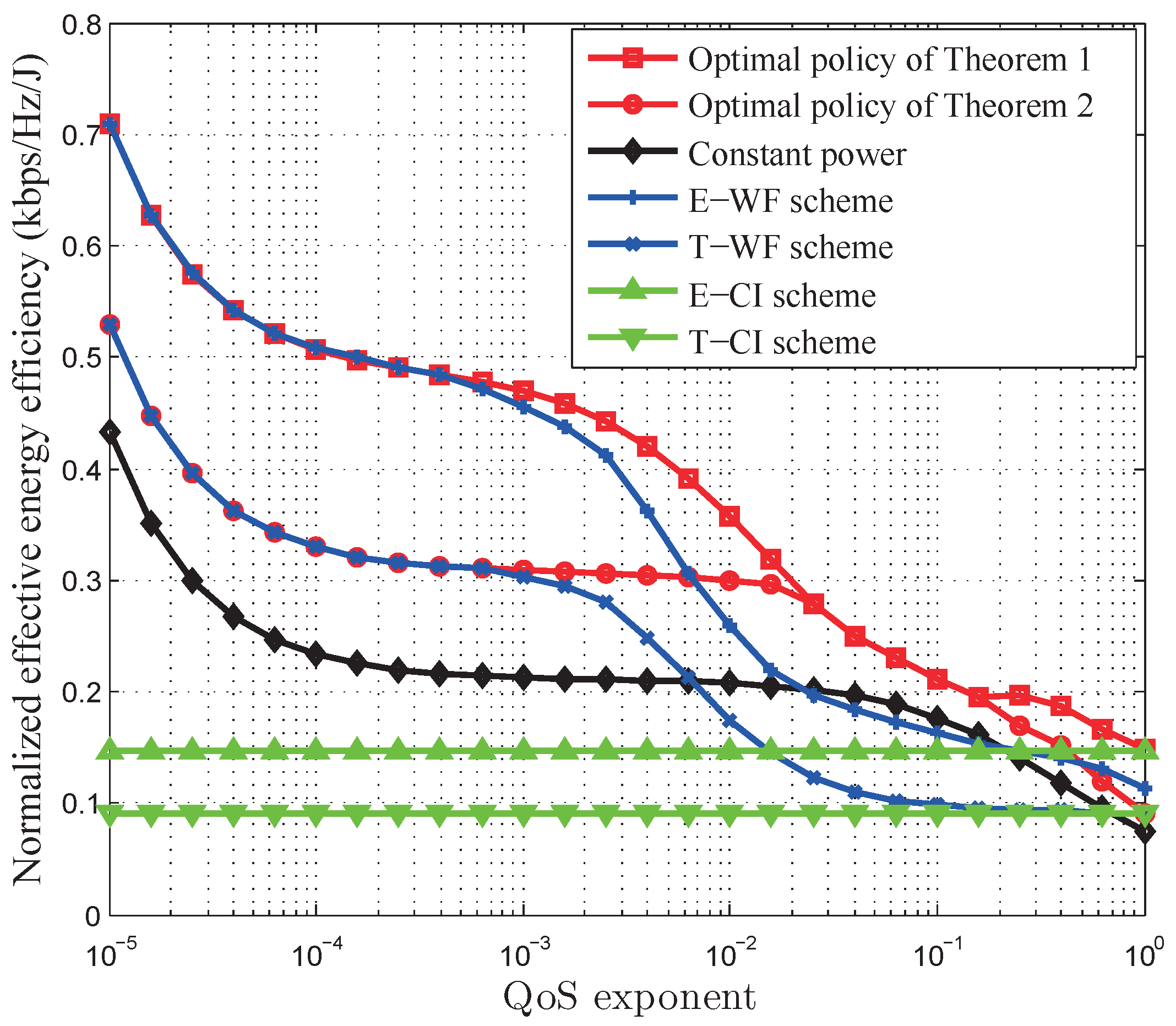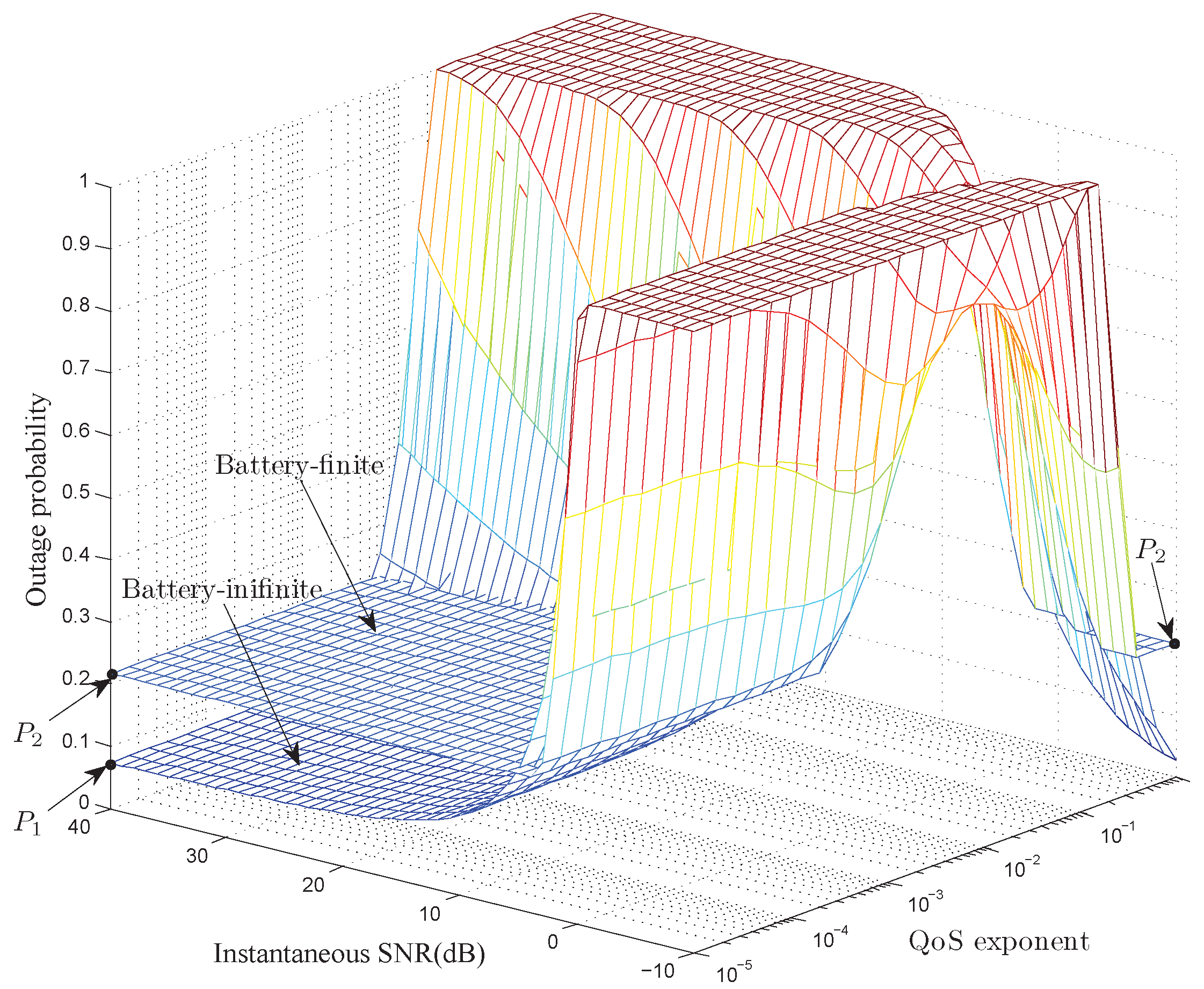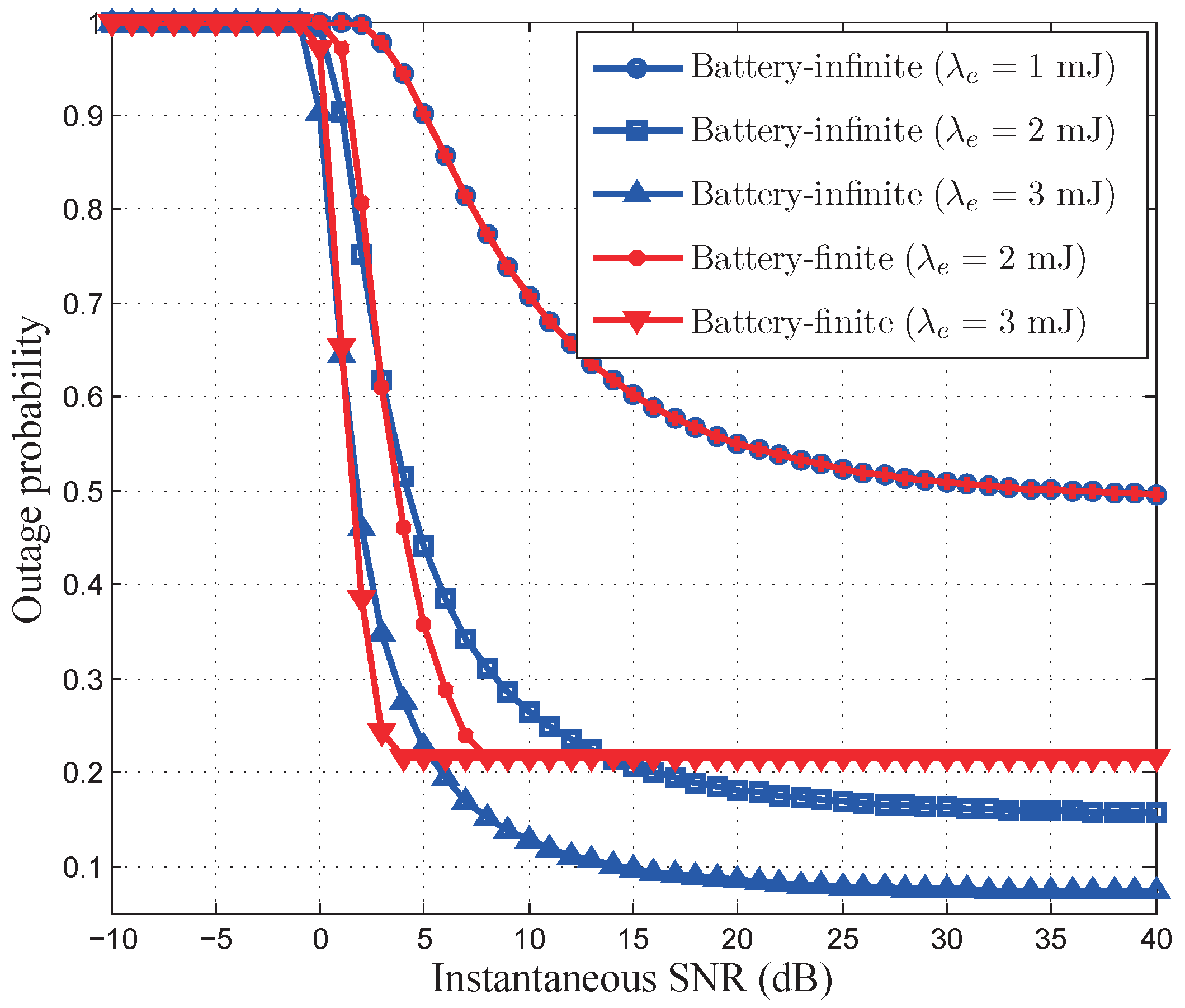1. Introduction
Energy harvesting offers a promising solution to prolong the lifetime of battery-powered wireless sensor networks. Different from the conventional energy supplies that suffer from limited lifetime, energy harvesting can provide the never-ending supply of energy for wireless sensor networks [
1,
2,
3,
4]. A large number of renewable energy sources, i.e., radio frequency (RF) signal, thermoelectric generator, vibration absorption device, etc. [
5,
6], can be exploited to harvest energy for wireless sensor nodes. Due to the random distribution and mobility of harvested energy powered sensor nodes, the energy harvesting often intermittently occurs, resulting in the very low energy efficiency for wireless sensor networks [
7,
8]. Therefore, it is very important to significantly increase the energy efficiency for energy harvesting based wireless sensor networks.
Recently, the energy efficiency in energy harvesting based wireless communications and networks were studied [
9,
10,
11]. The authors of [
9] developed the power allocation scheme to maximize the energy efficiency of orthogonal frequency division multiple access (OFDMA) based wireless powered communications. In order to improve energy efficiency, the authors of [
10] jointly exploited full-duplex and massive multiple-input multiple-output (MIMO) technologies in energy harvesting based small cell networks. The joint energy allocation and energy cooperation scheme is proposed in [
11] to maximize the energy efficiency for macro-small wireless networks, where each small-cell harvest energy from the energy sources. These works mainly optimize the energy efficiency under the short-term causal energy constraint. However, in practice, the harvested energy for the transmitter is sporadic and fluctuated [
12]. The energy needs to be eventually accumulated up to a certain amount in the rechargeable battery for future data transmissions [
8]. Hence, it is needed to resort to the long-term energy harvesting model [
7,
13,
14,
15,
16]. In [
7], a distributed power allocation, power splitting and relay selection algorithm is proposed to maximize the energy efficiency for cooperative clustered wireless sensor networks. The authors of [
13,
14] optimized the energy efficient resource allocation for the RF energy harvesting based collaborative mobile clouds. The authors of [
15] maximized the cumulated throughput for RF based harvest-and-use and harvest-store-use schemes, respectively. Based on the Markov decision process framework, the net bit rates are maximized in [
16]. However, how the battery capacity limitation impacts the resource allocation is not well studied in this literature. In fact, conservative or overly aggressive use of the harvested energy will either fail to utilize the excess energy or run out of the energy stored in the battery [
3,
4]. Even though some literature considered the battery-less energy harvesting sensor networks [
17], the battery-less often needs the specific hardware design or the assumption for continuous energy supply. The energy harvesting based wireless sensor networks we considered are often intermittent and sporadic. Thus, it is imperative to optimize the energy efficiency under the long-term statistical energy constraint for battery-infinite and battery-finite energy harvesting based wireless networks, respectively.
Furthermore, we need to not only optimize energy efficiency alone, but also guarantee the QoS for energy harvesting based wireless sensor networks [
18,
19]. By integrating the information theory with statistical QoS provisioning principle, a great deal of effort has been made to maximize the effective capacity [
20,
21,
22,
23], which is defined as the maximum constant arrival rate that can be supported by the service rate under specified QoS requirements. However, only a few research works focus on QoS provisioning in energy harvesting based wireless sensor networks [
24,
25,
26,
27,
28]. The magazine paper [
24] reviewed the techniques that provide QoS guarantees for energy harvesting based wireless networks. The authors of [
25,
26] employed the deterministic QoS metric to evaluate the energy harvesting based wireless sensor networks. However, in 5G energy harvesting powered communications, statistical QoS guarantee, which is ignored in these works, is practical but more challenging. For statistical delay-bounded QoS provisioning, the authors of [
27] maximized the effective capacity based on the state transition model while the authors of [
28] analyzed the battery-outage and buffer-overflow probabilities to characterize the effective capacity of energy harvesting based wireless networks. However, due to the unreliable nature of energy harvesting, how the energy arrival rate affects the energy harvesting based wireless networks, which is not taken into account in both [
27,
28], is still an open problem.
To remedy the above deficiencies, in this paper, we propose the statistical delay-bounded QoS-driven power control policies to maximize the effective energy efficiency (EEE), which is defined as the achieved effective capacity per unit harvested energy, under the statistical average constraints and the battery capacity constraints for energy harvesting based wireless sensor networks. First, we convert the causality constraints into long-term statistical average constraints. Second, we formulate the EEE maximization problems for the battery-infinite and battery-finite energy harvesting based wireless sensor networks, respectively. Third, we develop the optimal power control policies to maximize the EEE of energy harvesting based wireless sensor networks. Our developed optimal power control policy in battery-infinite energy harvesting based wireless sensor networks varies from the Energy harvesting Water Filling (E-WF) scheme (under the very loose QoS requirement) to the Energy harvesting Channel Inversion (E-CI) scheme (under the very stringent QoS requirement), while our developed optimal power control policy in battery-finite energy harvesting based wireless sensor networks varies from the Truncated energy harvesting Water Filling scheme (T-WF) (under the very loose QoS requirement) to the Truncated energy harvesting Channel Inversion (T-CI) scheme (under the very stringent QoS requirement). For battery-finite energy harvesting based wireless sensor networks, we derive and analyze the statistical QoS-driven power control policies under the following three scenarios: (i) the average harvested energy constraint dominated optimal power control policy, (ii) the battery capacity constraint dominated optimal power control policy, and (iii) both the average harvested energy constraint and the battery capacity constraint dominated optimal power control policy. Furthermore, we analyze the outage probability for our developed optimal power control policy. The numerical obtained results validate our analyses and show that our proposed QoS-driven power control polices can maximize the EEE for energy harvesting based wireless sensor networks, thus enabling efficient and QoS-guaranteed energy harvesting wireless communications in wireless sensor networks.
The rest of this paper is organized as follows.
Section 2 gives our QoS-guaranteed energy harvesting based wireless sensor network model and introduces the principle of effective energy efficiency.
Section 3 and
Section 4 develop the QoS-driven power control policies to maximize the effective energy efficiency for battery-infinite and battery-finite energy harvesting based wireless sensor networks, respectively.
Section 5 analyzes the energy outage probabilities and the data-transmission outage probabilities.
Section 6 numerically evaluates our developed QoS-driven power control polices for battery-infinite and battery-finite energy harvesting based wireless sensor networks, respectively. The paper concludes with
Section 7.
2. System Model
We consider an energy harvesting based wireless sensor network model, as shown in
Figure 1, where the energy harvesting enabled sensor nodes (SNs) communicate with the access point (AP). We concentrate on a discrete time system with a point-to-point link between the SN and WAP. Time division multiple access (TDMA) is employed for the SN-AP communications. In such scenario, incremental energy is harvested by the SN from the ambient energy sources and stored in the battery for data transmission.
A first-in-first-out (FIFO) data queue buffer is implemented at the SN, which contains the data packets from the upper-protocol-layer, as illustrated in
Figure 1. The packets are divided into frames at the data-link layer and split into bit-streams at the physical layer. The channel state information (CSI) is estimated at the AP and reliably fed back to the SN. The SN needs to find the optimal power control policy based on the QoS constraint requested by the service, the CSI fed back from the AP, and the available energy harvested from the environments.
We denote by
B,
, and
the total bandwidth of one SN-AP link, the average harvested energy, and the instantaneous transmit power, respectively, where
i is the time index of the frame. The additive white Gaussian noise (AWGN) is denoted by
. The channel power gains, denoted by
, follow the stationary block fading channel model, where they keep unchanged within the time duration of one frame, but vary independently across different frames. The instantaneous channel signal-to-noise ratio (SNR), denoted by
, can be expressed as
. Moreover, we employ Nakagami-
m fading channel model, which is very general and often best fits the land-mobile and indoor mobile multi-path propagations. The probability density function (PDF) of instantaneous channel SNR, denoted by
, can be expressed as follows:
where
denotes the Gamma function,
m represents the fading parameter of Nakagami-
m distribution, and
is the average received signal-to-noise ratio.
2.1. The Statistical Delay-Bounded QoS Guarantees
Based on large deviation principle (LDP), the author of [
29] showed that, for a queueing system with stationary and ergodic arrival and service process, the queue length process
converges in distribution to a finite random variable
that satisfies
which states that the probability of the queue length exceeding the queue length bound
x decays exponentially as the bound
x increases. The parameter
(
), which is called
QoS exponent [
21], indicates the exponential decay rate dominated by the queue length bound. A large
leads to a fast decay rate, which implies that a stringent QoS demand is supported. A small
corresponds to a slow decay rate, which means that the system can provide a loose QoS requirement [
30].
The sequence {
} is defined as a discrete-time stationary and ergodic stochastic service process, and
is the partial sum of the service process over time sequence of
. The Gartner–Ellis limit of
, expressed as
, is a convex function differentiable for all real
[
29]. The instantaneous service rate
can be derived as follows [
31]:
where
is the power control policy. We define the power control policy as the proportion of transmit power in the average harvested energy. Thus, the instantaneous transmit power can be written as
When the service rate sequence
is stationary and time-uncorrelated, we can derive the effective capacity as follows [
21]:
2.2. Effective Energy Efficiency in Energy Harvesting Based Wireless Sensor Networks
The SN harvests energy from the environments and stores it in the battery. The energy arrives at discrete time intervals with various amounts. We assume that the energy arrival process is stationary and ergodic, and thus can be modeled as the Poisson process with the arrival rate
[
4,
32]. Therefore, according to the Poisson process based energy arrival [
4,
32], the average harvested energy, denoted by
, is equivalent to the energy arrival rate and can be derived as follows:
where
is the harvested energy during the
time frame.
We aim to maximize the energy efficiency under the statistical delay-bounded QoS provisioning for energy harvesting based wireless sensor networks. Thus, we define the
effective energy efficiency (EEE), denoted by
, as the achieved effective capacity per unit harvested energy. Then, we can derive the EEE for energy harvesting based wireless sensor networks as follows:
Without loss of generality, we normalize the observation time interval. Thus, the terms of power and energy can be interchangeably used.
6. Performance Evaluation
In this section, we conduct numerical analyses to evaluate the performance of our proposed QoS-driven power control policies for energy harvesting based wireless sensor networks. Throughout the simulation, we use normalized effective energy efficiency and normalized effective capacity (EC), which are defined as the EEE and EC per Hz per second, respectively, to evaluate the performance of the energy harvesting based wireless networks. We also set the bandwidth, the time frame length, the maximum battery capacity and the parameters of Nakagami-m channel model to be , , , , and .
In order to numerically analyze the threshold
for energy constraints, we plot the transmit power curves versus the instantaneous SNR in
Figure 4 and
Figure 5, where the QoS constraint
is set to be 0.01 and 0.1, respectively. Observing
Figure 4 and
Figure 5, we find that the transmit power curves are concave when
is very small and convex when
is very large. This validates our analyses for threshold
of energy constraints in
Section 4.3. The maximum value of transmit power, which corresponds to the thresholds
, can be obtained at the stationary points in
Figure 4 and
Figure 5, i.e., when
and
,
, which represents that if
, the optimal power control policy is dominated only by the average harvested energy constraint under this circumstance.
Figure 4 and
Figure 5 also illustrate that, for different energy arrival rates and under different QoS constraints, we can obtain different energy constraints’ thresholds
. This verifies that
depends on the energy arrival rate
and QoS constraint
.
Figure 6 and
Figure 7 depict the normalized EEE and the normalized EC of our developed optimal power control policy versus energy arrival rate
. As illustrated in
Figure 6 and
Figure 7, EEE decreases as energy arrival rata increases while EC increases as energy arrival rate increases. This indicates that there is a trade-off between the EEE and EC. Also illustrated in
Figure 6 and
Figure 7, for
(under the QoS constraint
) and
(under the QoS constraint
), respectively, both the optimal power control policies in battery-infinite and battery-finite energy harvesting based wireless sensor networks have the same EEE and EC. This is because the instantaneous power control policy given by Proposition 1 is only limited by average harvested energy in the low energy arrival rate region. Therefore, when
(under the QoS constraint
) and
(under the QoS constraint
), the EEE and EC are not limited by the battery capacity. However, the battery capacity limits the EEE and EC in the high energy arrival rate region. For this reason, the optimal power control policy for battery-infinite energy harvesting based wireless sensor networks achieves much larger EEE and EC than that for battery-finite energy harvesting based wireless sensor networks when
(under the QoS constraint
) and
(under the QoS constraint
). We can also observe from
Figure 6 and
Figure 7 that, under the QoS constraint
, both the the battery-infinite and battery-finite energy harvesting based wireless sensor networks have the same EEE and EC when
is less than 4. This indicates that, when the QoS constraint is very stringent, the optimal power control policy for battery-finite energy harvesting based wireless sensor networks is not limited by battery capacity until the networks have a relatively large energy arrival rate.
Figure 8 depicts the normalized EEE of the optimal power control policy versus the QoS exponent, where the energy arrival rate
is fixed to 2 and 3, respectively. As shown in
Figure 8, the normalized EEE decreases as the QoS exponent
increases. This indicates that the looser the traffic QoS constraint is, the larger EEE we can achieve. In addition, the optimal power control policy in battery-infinite energy harvesting based wireless sensor networks can achieve larger EEE than that in battery-finite energy harvesting based wireless sensor networks when the QoS constraint is very loose or very stringent. This is due to the reason that the QoS-driven power control policy in battery-finite energy harvesting based wireless sensor networks is limited by the battery capacity in the high SNR region when the QoS requirement is very loose and in the low SNR region when the QoS constraint is very stringent. When the QoS constraint is not very loose or not very stringent, both the QoS-driven power control policies for the battery-infinite and battery-finite energy harvesting based wireless sensor networks have the same EEE. This is because the maximum instantaneous transmit power is always less than the battery capacity when the QoS constraint is not very loose or not very stringent.
Figure 9 compares the performance of our developed optimal power control policy with other existing schemes, i.e., the related research works [
25], E-WF scheme, and constant power allocation scheme. We find that both the power control policies with QoS provisioning specified in this paper and [
25] can achieve better performance than the power control policies without QoS provisioning, i.e., the E-WF scheme and the constant power allocation. In addition,
Figure 9 also shows that our developed optimal power control policy in Theorem 1 can achieve larger EC than the power control policy in [
25]. This is because in [
25] the data rate QoS requirement is considered, which is deterministic QoS, while our developed optimal power control policy provides the statistical QoS guarantees, which is adaptive to diverse delay-bounded QoS constraints, thus achieving the maximum EC. To further verify the analyses in this paper, we plot normalized EEE of the optimal power control polices developed in Theorems 1 and 2, constant power allocation, E-WF scheme, T-WF scheme, E-CI scheme, and T-CI scheme in
Figure 10. We can observe that our developed QoS-driven power control policies, which are the solution of Theorems 1 and 2, can achieve larger EEE than other schemes for energy harvesting based wireless sensor networks. When the QoS constraint is very loose, our developed QoS-driven power control policy for battery-infinite energy harvesting based wireless sensor networks converges to the E-WF scheme and our developed QoS-driven power control policy for battery-finite energy harvesting based wireless sensor networks converges to the T-WF scheme. When the QoS requirement is very stringent, our QoS-driven optimal power control policy for battery-infinite energy harvesting based wireless sensor networks converges to the E-CI scheme and the QoS-driven power control policy for battery-finite energy harvesting based wireless sensor networks converges to the T-CI scheme.
Figure 11 and
Figure 12 illustrate the outage probabilities of our developed optimal power control policies. As depicted in
Figure 11, when the QoS exponent
is very small, the outage probability for battery-infinite energy harvesting based wireless sensor networks converges to 1 in the low SNR region and
in the high SNR region, while the outage probability for battery-finite energy harvesting based wireless sensor networks converges to 1 in the low SNR region and
in the high SNR region. In addition, when the QoS exponent
is very large, the outage probability for battery-infinite energy harvesting based wireless sensor networks converges to zero in the low SNR region and 1 in the high SNR region, while the outage probability for battery-finite energy harvesting based wireless sensor networks converges to
in the low SNR region and 1 in the high SNR region. Note that the corresponding lower bounds
and
can be obtained from Lemmas 2 and 3, respectively. In
Figure 12, we plot the outage probability curves versus the instantaneous SNR under the QoS constraint
, where the energy arrival rate is set to be 1, 2, and 3, respectively. As depicted in
Figure 12, when energy arrival rate is 1, the battery-infinite outage probability is the same as battery-finite outage probability. When energy arrival rate is 2 or 3, the battery-infinite energy harvesting based wireless sensor networks achieve a smaller outage probability than the battery-finite energy harvesting based wireless sensor networks. This is because the optimal power control policy is not constrained by the battery capacity when energy arrival rate is 1. Thus, both battery-infinite and battery-finite energy harvesting based wireless sensor networks have the same outage probability. When energy arrival rate is 2 or 3, the optimal power control policy is limited by the battery capacity in battery-finite energy harvesting based wireless sensor networks. Thus, the battery-finite energy harvesting based wireless sensor networks have the larger outage probability than the battery-infinite energy harvesting based wireless sensor networks.
